Citizens' forums, and attitudes to agriculture, environment and rural priorities: research report
Results of an independent study into Scottish public attitudes to the environment, agriculture and rural development.
Appendix C: Survey research findings
To establish a baseline of public attitudes towards agriculture, environment and rural communities, a nationally representative survey of 2,345 Scottish adults (16+) was carried out.
The survey was conducted online between the 3rd and 14th of December 2018.
The achieved sample profile is representative of the Scottish population in terms of gender, age, social grade, and location. Where there were shortfalls in the achieved sample, weighting was applied based on Scottish mid-population estimates.
| Achieved sample profile | Population profile | |||
|---|---|---|---|---|
| Variable | % | N | % | N |
| Gender | ||||
| Female | 57% | 1326 | 2,640,300 | 51% |
| Male | 43% | 1019 | 2,784,500 | 49% |
| Age | ||||
| 16-34 | 12% | 286 | 1,383,977 | 30% |
| 35-44 | 10% | 245 | 664,086 | 15% |
| 45-54 | 21% | 498 | 792,119 | 17% |
| 55-64 | 31% | 717 | 707,897 | 16% |
| 65+ | 26% | 599 | 1,012,567 | 22% |
| Social Grade | ||||
| ABC1 | 55% | 1296 | 1,725,871 | 50% |
| C2DE | 45% | 1048 | 1,703,190 | 50% |
| Urban-Rural 6 | ||||
| Large Urban Areas | 35% | 832 | 1,890,444 | 35% |
| Other Urban Areas | 32% | 760 | 1,888,164 | 35% |
| Accessible Small Towns | 8% | 188 | 503,819 | 9% |
| Remote Small Towns | 3% | 76 | 185,572 | 3% |
| Accessible Rural | 13% | 312 | 623,109 | 12% |
| Remote Rural | 8% | 177 | 313,592 | 6% |
| Total | 100% | 2,345 | 5,424,800 | 100% |
The survey explored attitudes towards agriculture, environment and rural communities as well as priorities for future policy in these areas, post-CAP.
Quantitative research findings
Before reviewing perceptions and priorities for agriculture, environment and rural communities in turn, respondents to the survey were invited to indicate the government portfolios that should be prioritised in terms of government spending.
The results are pertinent when considering the relative importance of each of the three aspects of the CAP.
Among the three policy areas of the CAP, the environment was cited by a fifth of respondents (20%), however agriculture (5%) and rural development (3%) featured less frequently in terms of priorities for government spending.
Relative importance of a range of government portfolios
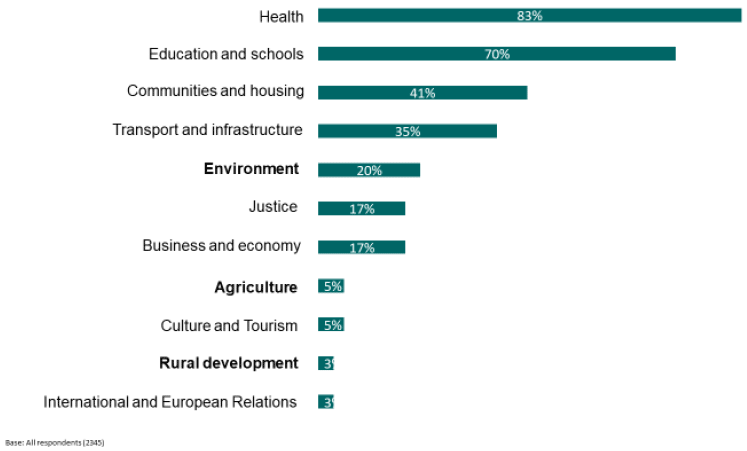
Younger people were more likely than those in older age groups to cite the environment as a priority for government spending (29% among those aged 16-34 comparative to 16% among 45-54; 17% among 55-64; and 15% among 65+).
Agriculture and rural development were attributed higher importance among those in accessible rural and remote rural locations than those in urban areas and small towns.
Agriculture and rural development priority for government spending by 6-fold urban-rural classification
| Overall % | Remote rural % | Accessible rural % | Remote small towns % | Acessible small towns % | Other urban areas % | Large urban areas % | |
|---|---|---|---|---|---|---|---|
| Agriculture | 5 | 14 | 8 | 8 | 4 | 3 | 4 |
| Rural development | 3 | 12 | 7 | 6 | 6 | 1 | 2 |
Another important variation in the results is in relation to the priority attributed to business and economy in terms of government spending among those in remote rural locations comparative to all other location breakdowns by the six-fold classification (32% in remote rural compared to 15% accessible rural; 17% remote small towns; 9% accessible small towns; 15% other urban areas; and 18% large urban areas).
Food consumption factors
Animal welfare (21%), impact on health (20%), and cost (19%), were the most commonly cited "essential" factors that inform decisions about food consumption.
Importance of a range of food consumption factors
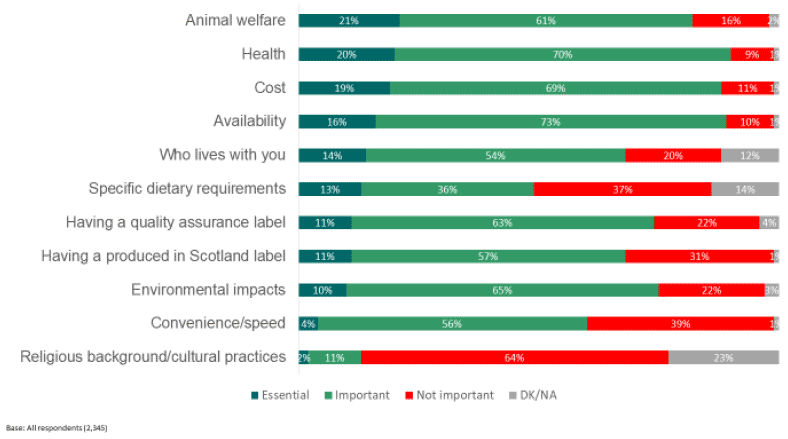
There is a correlation among these factors and social grade, with cost being more of an essential or important factor for those in the C2DE social grade category comparative to those in the ABC1 social grade category; and conversely health and animal welfare being more of an essential or important factor for those in the ABC1 social grade category than those in the C2DE social grade category.
In addition there was some notable variation by a range of different demographic factors:
- The availability of food items in the shops near you, was more likley to be an essential factor for those residing in remote rural locations than overall (27% compared with 16%).
- The impact on health, was more important for older age groups than overall (45% of 65+ said it was very important compared with 35% overall).
- Animal welfare was more likely to be cited as an essential factor among women than men (24% compared with 17% among men).
In addition to a range of factors which may influence food consumption factors, the issue of location was explored in the survey to assess the extent to which the geography of food production matters when choosing what to eat.
A third (33%) said that food produced in Scotland was the single most important factor when choosing the food that they eat comparative to other geographic breakdowns; 29% didn't mind where the food they eat comes from, and 26% said that they preferred that their food was produced in the UK.
Relatively smaller proportions said that they preferred food produced in the European Union (4%), food produced in my region of Scotland (3%), and food produced in my local community (2%).
Importance of the location of food production
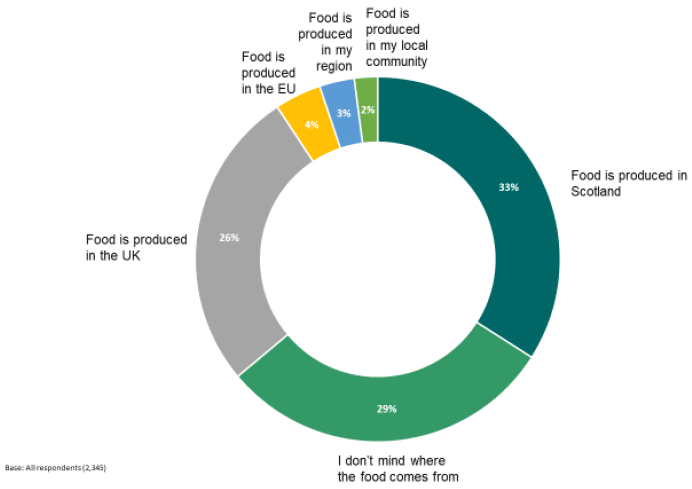
When looking at the issue of location, it can be seen that 11% said that it was essential for them that the food they consume has a produced in Scotland label compared to 38% who said that it was important for them that food was produced in Scotland (combining Scotland, region and local community values). These results indicate that while geography is an important factor underpinning choices about food consumption, this is not necessarily picked up in terms of the branding of food products.
In terms of variation in the results, those in urban areas were more likely than overall to say that they didn't mind where the food they eat comes from (33% compared with 29%). Conversely, those in remote rural locations were more likely than overall to say that it was important that food is produced in their local area (8% compared with 2% overall). These figures should be treated with caution as they are on the threshold of signficance.
When considering the impact of Brexit on food consumption factors, there was a perception that Brexit would have a predominantly negative impact on factors that affect food choice. Importantly, 68% think that Brexit will have a negative impact on cost which is one of the most essential factors driving food consumption choices.
The impact of Brexit on a range of food consumption factors
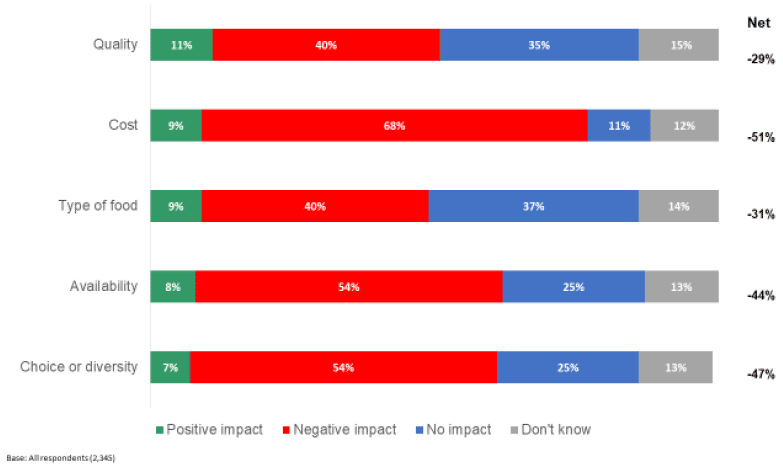
For all factors, those in the ABC1 social grade category were more likely than those in the C2DE social grade category to think that Brexit will have a negative impact.
Impact of Brexit by social grade (% Negative impact)
| Overall % | ABC1 % | C2DE % | |
|---|---|---|---|
| Quality | 40 | 43 | 36 |
| Cost | 68 | 71 | 64 |
| Type of food | 40 | 44 | 36 |
| Availability | 54 | 59 | 49 |
| Choice or diversity | 54 | 58 | 50 |
Another important variation is age whereby younger age groups were more likely than older age groups to think that Brexit will have a negative impact on a range of food consumption factors. Conversely, older age groups were more likely than the rest of the sample to think that Brexit will have no impact on the different factors explored in the survey.
Impact of Brexit by age (% Negative impact)
| Overall % | Under 35 % | 35-44 % | 45-54 % | 55-64 % | 65+ % | |
|---|---|---|---|---|---|---|
| Quality | 40 | 46 | 41 | 41 | 38 | 30 |
| Cost | 68 | 76 | 71 | 70 | 65 | 55 |
| Type of food | 40 | 44 | 44 | 41 | 39 | 33 |
| Availability | 54 | 61 | 57 | 55 | 50 | 45 |
| Choice or diversity | 54 | 62 | 57 | 55 | 51 | 45 |
Perceptions and priorities for Scottish Agriculture
There was widespread agreement (86%) that Scottish farming is vital for the success of the Scottish economy. A similar proportion (83%) agreed that Scottish farming provides a vital public service to the people in Scotland.
Given the value attributed to Scottish farming, it is perhaps unsurprising that two-fifths (42%) of the sample disagreed that Scottish farmers receive a fair share of money for the food they produce.
When looking at the relationship between farming and the environment, the results were more mixed:
- 45% agreed that Scottish farming could do more to mitigate any negative impacts of farming on climate change
- 28% agreed that Scottish farming does not do enough to protect the natural environment and encourage biodiversity; an equal proportion (28%) disagreed with this statement
These results indicate that the linkages between agriculture and the environment are not prima facie clear to respondents to the survey.
Perceptions of Scottish agriculture
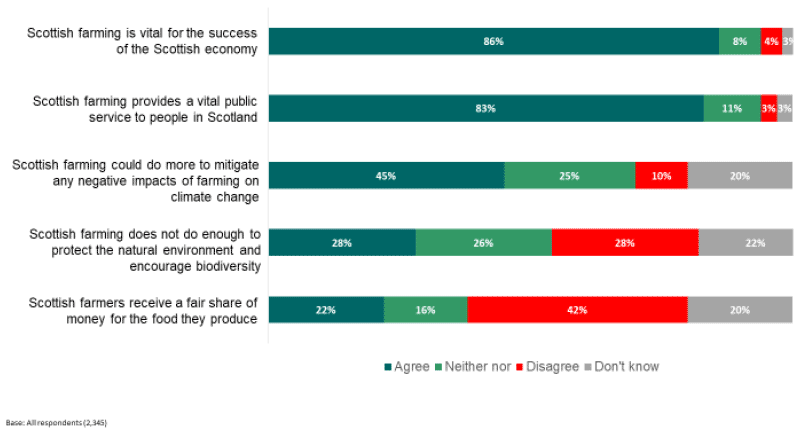
Nonetheless, the linkages between farming and the natural environment were sharper for those in rural areas compared with overall: those in remote rural areas were more likely than overall to strongly agree that Scottish farming could do more to mitigate any negative impacts of farming on climate change (19% compared with 13%); moreover, those in remote rural areas were more likely than overall to strongly agree that Scottish farming does not do enough to protect the natural environment and encourage biodiversity (11% compared with 7%).
There were also gender differences in relation to attitudes towards Scottish agriculture. Women were more likely than men to strongly agree that Scottish farming is vital to the success of the Scottish economy (51% compared with 40% among men); moreover, they were also more likely to strongly agree that Scottish farming provides a vital public service to people in Scotland (46% compared with 39% among men). Given the foregoing results it is perhaps unsurprising that men were more likely than women to agree (combined strongly agree/tend to agree) that farmers receive a fair share of money for the food they produce (26% compared with 18% among women).
There were no striking variances by urbanity/rurality in the results, however those in remote rural locations were more likely to express ambivalence e.g. a "neither agree nor disagree" response with respect to the statement that "Scottish farming provides a vital public service to Scottish people": the figure for remote rural (26%) was significant against all other location breakdowns by the six-fold classification (26% among remote rural compared with 11% among accessible rural, 9% among remote small towns, 5% among accessible small towns, 12% among other urban areas and 9% among large urban areas).
When thinking about priorities for Scottish agriculture, just under half of the sample (48%) highlighted the issue of discouraging the use of pesticides and antibiotics; two-fifths (40%) wanted government to focus on the issue of helping farmers sell more food in local shops and supermarkets, and a similar proportion (39%) wanted future government funding to focus on the issue of animal welfare.
Priorities for the future funding of agriculture
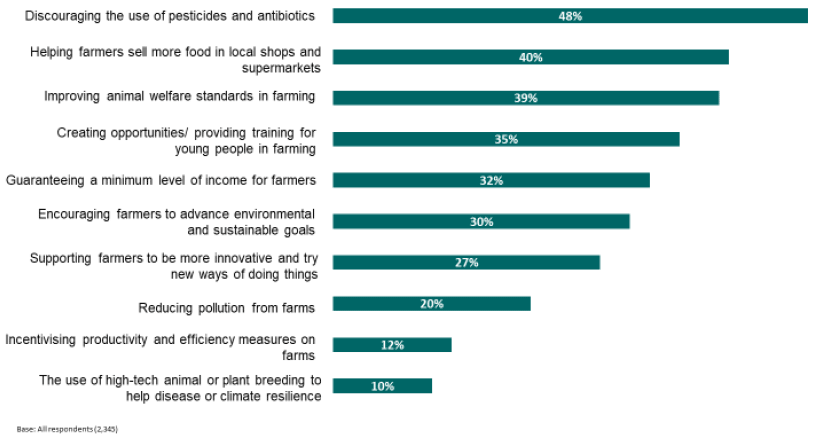
There were some variation in the data by age:
- Older age groups were more likely than younger age groups to want government funding to focus on the issue of discouraging pesticides and antibiotics.
- Younger age groups were more likely than older age groups to want government to focus on issues concerning the environment e.g. reducing pollution from farms and encouraging farmers to advance environmental and sustainable goals. Moreover, younger age groups are more likely to prioritise guaranteeing a minimum level of income for farmers.
Priorities for future spending in farming and agriculture in Scotland by age
| Overall % | Under 35 % | 35-44 % | 45-54 % | 55-64 % | 65+ % | |
|---|---|---|---|---|---|---|
| Discouraging the use of pesticides and antibiotics | 48 | 42 | 43 | 46 | 53 | 55 |
| Helping farmers sell food in local shops | 40 | 39 | 44 | 42 | 40 | 38 |
| Improving animal welfare standards | 39 | 35 | 48 | 44 | 40 | 32 |
| Creating opportunities/ providing training for young people | 35 | 32 | 35 | 36 | 37 | 36 |
| Guaranteeing a minimum level of income fo farmers | 32 | 39 | 33 | 30 | 29 | 27 |
| Encouraging farmers to advance environmental and sustainable goals | 30 | 36 | 28 | 28 | 29 | 27 |
| Supporting farmers to be more innovative | 27 | 20 | 29 | 31 | 30 | 31 |
| Reducing pollution from farms | 20 | 27 | 15 | 18 | 16 | 18 |
| Incentivising productivity and efficiency measures | 12 | 11 | 11 | 11 | 11 | 17 |
| The use of high-tech animal or plant breeding to help disease or climate resilience | 10 | 12 | 10 | 6 | 7 | 11 |
Corresponding with the high level of importance attributed to the issue of discouraging the use of pesticides and antibiotics in farming, it is unsurprising that a clear priority for the future funding of food production and consumption was ensuring that food is healthy and safe (58%). Following this, there was a preference for government funding to advance the dual aims of ensuring affordable prices for consumers (49%) as well as ensuring fair food prices for producers (42%).
Quality and sustainable food production (39% respectively) were lesser mentioned priorities in terms of the future funding of food production and consumption.
Priorities for the future of farming and food production
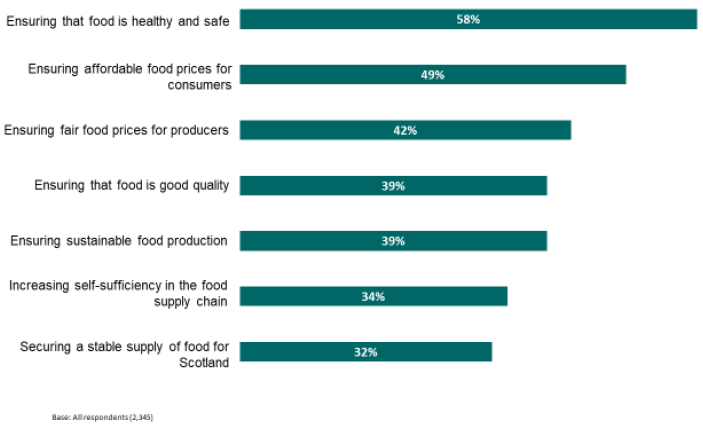
When looking at differences in the results, those in mainly rural locations based on the RESAS classification for urban/rural were more likely than those in urban areas with substantial rural areas to place a priority on ensuring fair food prices for producers (46% compared with 38%) and securing a stable supply of food for Scotland (38% compared with 31%), therefore considering the implications of food production for the wider agricultural sector.
Conversely, those in urban with substantial rural areas were more likely than those in mainly rural locations to prioritise ensuring affordable food prices for consumers (53% compared with 45%).
Perceptions and priorities for the environment
While perceptions of the link between the issue of agriculture and biodiversity were split; almost all (90%) perceived it to be an important environmental issue.
Eight-in-ten agreed that the quality of drinking water in Scotland is greater than in other parts of the UK, and seven-in-ten agreed that air pollution is one of the main causes of climate change. A similar proportion (68%) disagreed that soil is not equally as important as air and water as a natural asset.
Perceptions of the environment
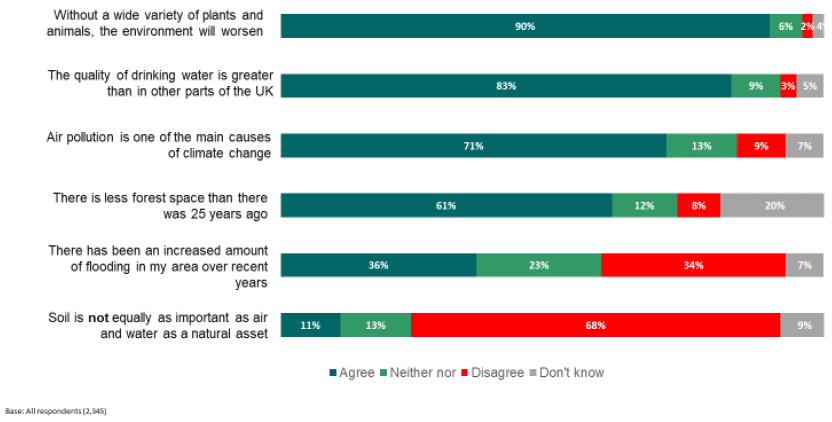
Those in accessible rural locations were more likely than those in large urban areas to strongly agree that without a wide variety of plants and animals, the environment will worsen (63% compared with 54%). These findings are consistent with the earlier section on agriculture and the environment and the higher levels of agreement found on the issue of climate change and biodiversity among those in rural areas.
There were higher levels of agreement that the quality of drinking water in Scotland is greater than in other parts of the UK in urban areas comparative to rural areas, which may in part be related to the higher prevalence of private water supplies in rural locations (56% in large urban areas strongly agree; 57% in other urban areas; 66% in accessible small towns; 55% in remote small towns compared with 47% in accessible rural; and 39% in remote rural.
Those aged 65+ were more likely than all other age categories to tend to disagree that there is less forest space than there was 25 years ago (12% among 65+ compared with 5% among under 35; 5% among 35-44; and 7% among 45-54 and 55-64 respectively).
Corresponding with attitudes towards the environment, respondents identified a range of key priorities for government spending on the environment. The top three priorities for government spending include investing in better flood prevention and management of flood water at times of flooding (59%); increasing the variety of plant and animal life (56%); and setting stricter targets for improving air quality (55%).
Priorities for the future of the environment
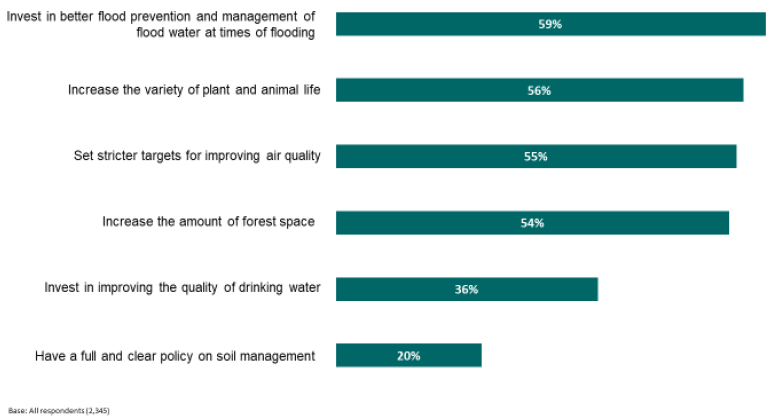
There were differences by age in terms of the issues that respondents wanted the government to focus on.
Those aged 65+ were more likely than younger age groups to want government to prioritise investing in better flood prevention and management, as well as having a full and clear policy on soil management. In contrast, those aged 35 and under, were more likely than older age groups to want government to focus on increasing the variety of plant and animal life, and the amount of forest space, which is consistent with the stronger environmental priorities found among young people throughout the survey.
Priorities for the future of the environment by age.
| Overall % | Under 35 % | 35-44 % | 45-54 % | 55-64 % | 65+ % | |
|---|---|---|---|---|---|---|
| Invest in better flood prevention and management | 59 | 52 | 56 | 58 | 63 | 68 |
| Increase the variety of plant and animal life | 56 | 61 | 61 | 53 | 52 | 49 |
| Set stricter targets for improving air quality | 55 | 61 | 54 | 53 | 52 | 52 |
| Increase the amount of forest space | 54 | 59 | 55 | 53 | 52 | 49 |
| Have a full and clear policy on soil management | 36 | 33 | 34 | 34 | 39 | 43 |
| Invest in improving the quality of drinking water | 20 | 17 | 21 | 24 | 20 | 17 |
Perceptions and priorities for rural communities
There is majority agreement that there is a lack of jobs and opportunities in rural areas, and reflecting this view, 64% agree that rural areas need more support than they currently receive.
In relation to services, 62% disagree that broadband availability is good in rural areas.
Perceptions of rural community issues
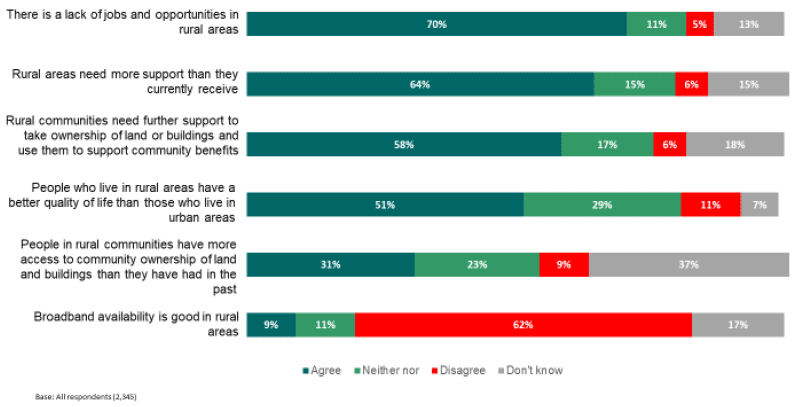
There were key variances in perceptions of rural community issues by urbanity and rurality.
- Those in rural locations - particularly remote small towns - were more likely than those residing in urban locations to agree that there is a lack of jobs and opportunities in rural areas and that rural areas need more support than they currently receive.
- The issue of broadband availability was particularly pronounced for those residing in remote small towns.
- Those in remote rural locations, were more likely than all other location breaks by the six-fold urban-rural classification to strongly agree that those living in rural areas have a better quality of life than those who live in urban areas.
On the issue of community ownership of land and buildings, there was a higher levels of agreement amog those in rural locations that rural communities have more access to community ownership than in the past. In contrast, there was a higher proportion of don't know responses among those residing in urban locations. Reflecting these results, those in rural locations were more likely than those in urban locations to agree that people in rural communities need more support to take ownership of lands and buildings and use them to support community benefits.
Attitudes towards rural communities by 6-fold urban-rural classification (agree %)
| Overall % | Remote rural % | Accessible rural % | Remote small towns % | Acessible small towns % | Other urban areas % | Large urban areas % | |
|---|---|---|---|---|---|---|---|
| Lack of jobs and opportunities in rural areas | 70 | 72 | 73 | 86 | 74 | 68 | 69 |
| Rural areas need more support than current | 64 | 76 | 75 | 78 | 56 | 63 | 58 |
| Rural communities need support to take community ownership of land and buildings | 58 | 67 | 57 | 62 | 64 | 59 | 54 |
| People who live in rural areas have a better quality of life than urban | 51 | 60 | 63 | 59 | 42 | 53 | 46 |
| Rural communities have better acces to community ownership than in the past | 31 | 55 | 33 | 37 | 26 | 28 | 30 |
| Broadband availability is good in rural areas | 61 | 62 | 58 | 61 | 49 | 64 | 73 |
There were a number of priorities which respondents expressed are important for government to focus on when considering the future of rural communities. Top priorities included: improving public transport links (65%); improving broadband connectivity (61%); and ensuring there are more jobs and opportunities for those who live in rural areas (52%).
Priorities for the future of rural communities
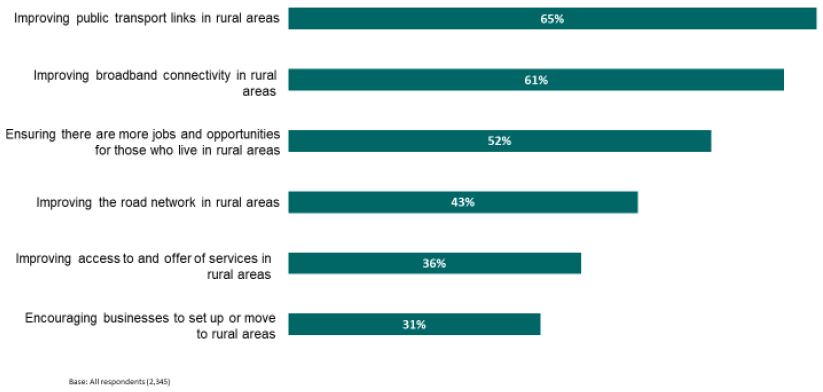
As can be expected, there were some variations in terms of the priorities for the future funding of rural communities by those in rural and urban locations.
- There was a higher level of importance attributed to improving broadband connectivity in remote rural locations than overall (73% compared with 61%).
- Furthermore, the issue of ensuring there are more jobs and opportunities for those who live in rural areas was stressed more strongly among those in remote small towns compared with overall (62% compared with 52%).
Notwithstanding the variance by urbanity and rurality, there was also variance in the data by age. Those aged 35 and under were more likely than the rest of the sample to want government to focus on improving access to and offer of services in rural areas (42% compared with 36%), which is pertinent when considering the out-migration of young people in rural areas.
Common Agricultural Policy
After considering each aspect of the Common Agricultural Policy independent of each other (agriculture, environment and rural communities), the survey explored the issues in amalgam to consider priorities for the funding of future policy.
Dissimilar to the current policy formulation, a quarter (26%) of the sample prefer all three areas of the Common Agricultural Policy (farmers and food production, environment and rural communities) to receive the same amount of the policy budget.
17% prefer a greater share of the policy budget being spent on supporting rural communities and protecting the natural environment; and a smaller proportion (15%) prefer to retain spending as it currently is with the vast proportion of the budget being spent on farmers and food production.
Preferences for future funding allocations within the CAP
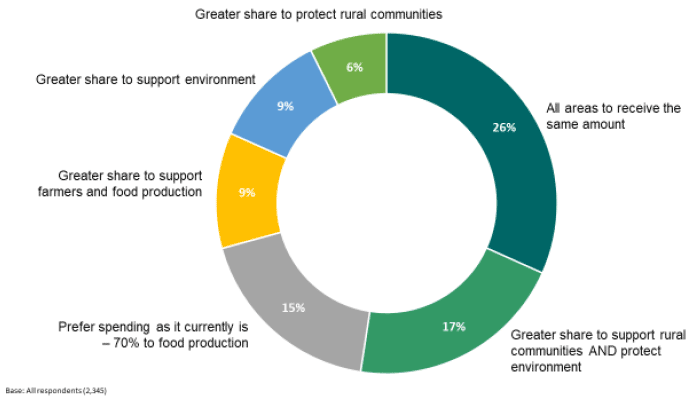
There were a number of key variations in the results:
- Urbanity and rurality is the most significant predictor of views on the allocation of spending for the CAP budget. Those residing in accessible rural locations were more likely than those in large urban areas and other urban areas to prefer to retain spending as it currently is, with the vast majority of the policy budget allocated to farming and food production (21% compared with 14% and 15% respectively).
- Women were more likely than men to prefer all three areas of the policy to receive the same amount (30% compared with 23%). By comparison, men were more likely than women to prefer a greater share of the budget going to support farmers and food production than present (12% compared with 9%).
- Those aged 35 and under were more likely than all other age categories to prefer a greater share of support to be allocated to support the natural environment (14% among under 35's compared with 7% among 35-44; 8% among 45-54; 8% among 55-64; and 6% among 65+).
While there was appetite for the reallocation of funding within the CAP budget moving away from the vast amount of spend on farming and food production towards a more equal approach with the other CAP priorities, there were also different views with respect to how the budget to farming and food production is allocated. 30% preferred support to farms to be based on maintaining a stable farming industry, and 24% preferred the budget to be based on farm size, with smaller farms and crofts receiving a greater share than at present. A smaller proportion of the sample (7%) preferred the budget to be distributed based on farm size, with larger farms with better quality land receiving the highest payments, as is currently applied.
Priorities for the future funding of farms
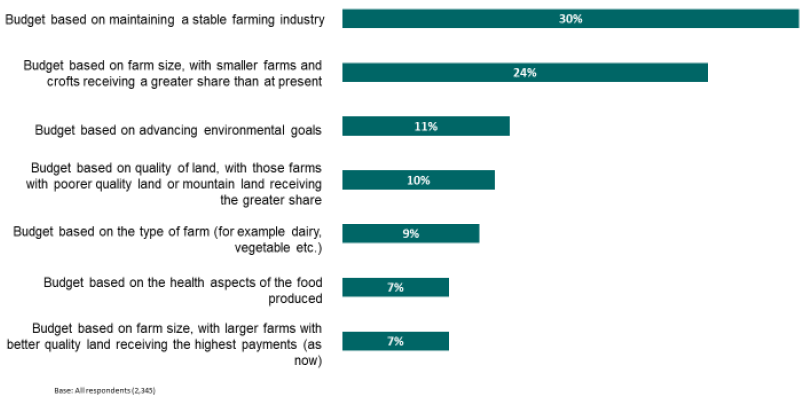
Those in remote rural and accessible rural locations were more likely than those in large urban areas to prefer funding to farms to be allocated based on the quality of land, with those farms with poorer quality land receiving the greatest share of funding (18% and 12% respectively compared with 7% among large urban areas). These results may be related to the higher prevalence of rough grazing or less favoured areas in these parts of Scotland.
There were also differences in the result by age: those aged 65+ were more likely than those under 35 to prefer funding farms to be based on maintaining a stable farming industry (37% compared with 24%). Furthermore, those aged under 35 were almost twice as likely as those aged 65+ to prefer funding to be based on advancing environmental goals (15% compared with 8%).
Looking specifically at the types of farms that should be prioritised in terms of the future funding of farms in Scotland, there was a clear preference to prioritise vegetable (44%) and dairy farms (42%). Lower proportions of the sample wanted funding to prioritise beef farms (27%), poultry farms (17%); and fish farms (13%).
Priorities for the future funding of different types of farms
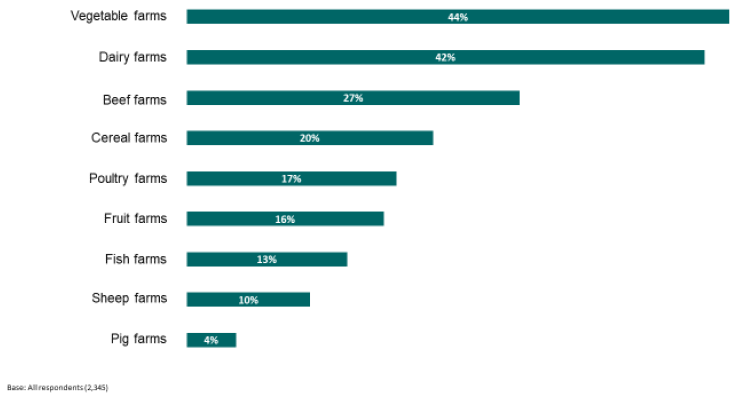
Those in remote rural locations were more likely than all other location breakdowns to prioritise funding of sheep farms (26% among those residing in remote rural locations compared with 9% among large urban areas; 10% other urban areas; 8% accessible small towns; 6% remote small towns; and 9% accessible rural).
Moreover, those in accessible small towns were more likely than overall to prioritise funding for dairy farms (56% compared with 42% overall).
There were also key differences by age with those in younger age groups more likely than older age groups to prioritise the funding of poultry farms and fish farms; in contrast older age groups were more likely to prioritise dairy and cereal farms.
Priorities for the funding of different types of farms by age
| Overall % | Under 35 % | 35-44 % | 45-54 % | 55-64 % | 65+ % | |
|---|---|---|---|---|---|---|
| Vegetable farms | 44 | 44 | 44 | 42 | 46 | 46 |
| Dairy farms | 42 | 38 | 36 | 49 | 44 | 44 |
| Beef farms | 27 | 26 | 30 | 28 | 27 | 25 |
| Cereal farms | 20 | 14 | 18 | 21 | 27 | 24 |
| Poultry farms | 17 | 21 | 21 | 15 | 12 | 13 |
| Fruit farms | 16 | 20 | 14 | 15 | 15 | 15 |
| Fish farms | 13 | 19 | 13 | 10 | 9 | 12 |
| Sheep farms | 10 | 8 | 10 | 11 | 12 | 12 |
| Pig farms | 4 | 5 | 4 | 3 | 3 | 2 |
Contact
There is a problem
Thanks for your feedback